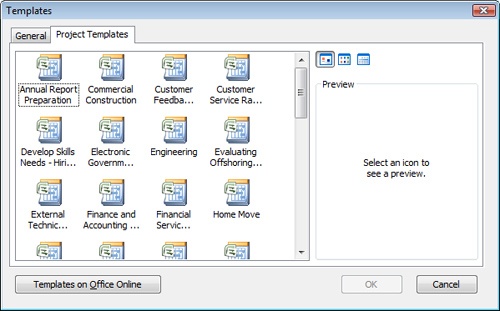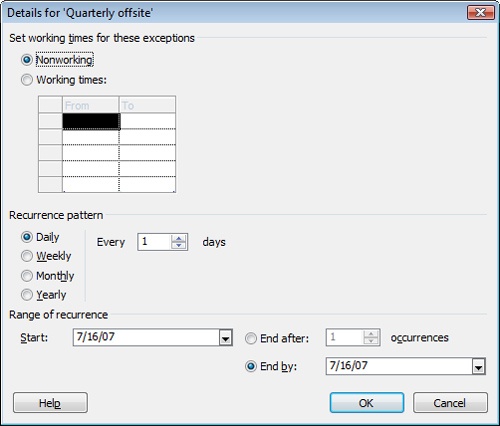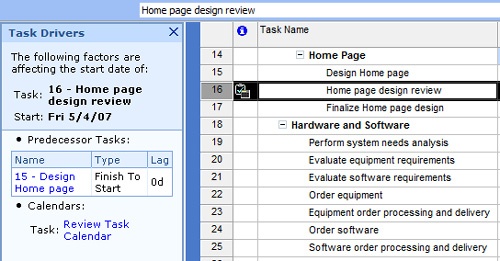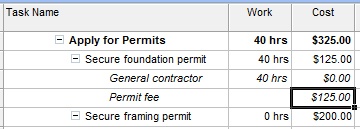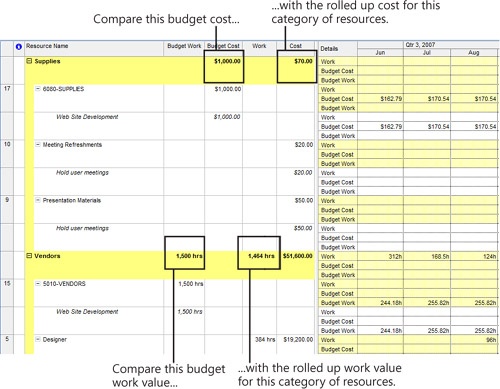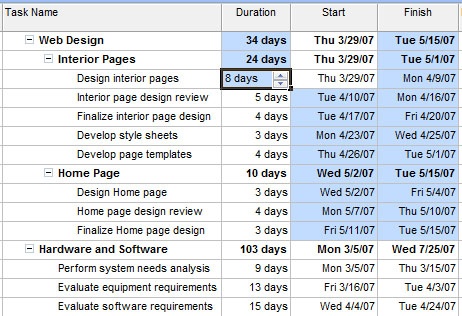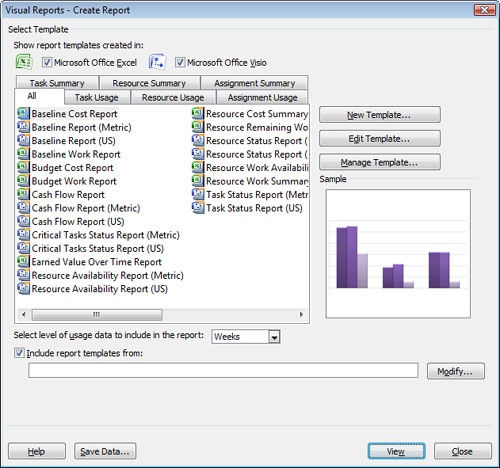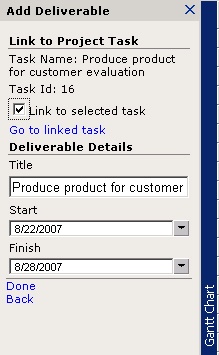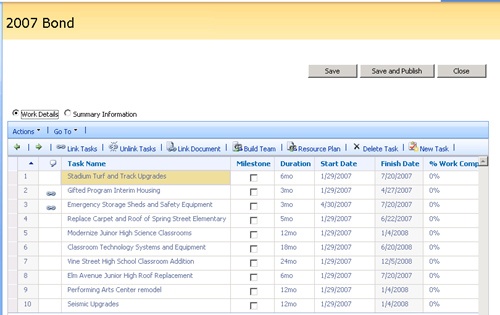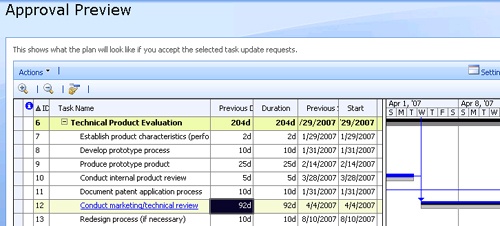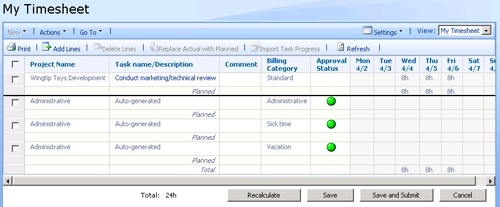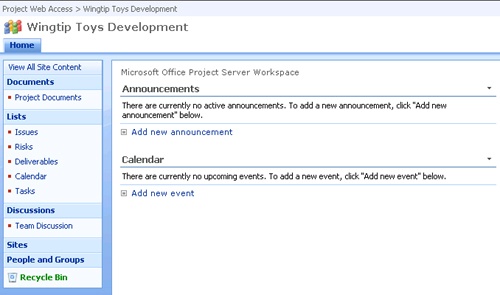Microsoft Office Project 2007 includes new features and significant improvements in the following areas:
Planning and scheduling
Tracking resource work, costs, and time reporting
Viewing and reporting on project information
Collaborating within the project groups and with other business systems
As in Microsoft Office Project 2003, there are two editions of Microsoft Office Project 2007: Project Standard and Project Professional. When used as a standalone desktop project management application for a single project manager, both editions have the same features. However, with the implementation of Project Server for enterprise project management, a host of additional features becomes available in Project Professional.
This section summarizes the new features in Project Standard, Project Professional, Project Server, and Project Web Access. Cross-references indicate where these new features are covered in more detail elsewhere in this book.
Highlights of the new version of Project Standard include the ability to undo multiple edits to your project plan. Through the new Task Drivers pane and change highlighting, you have more visibility into what’s happening with your schedule as you make changes. Thirty new project templates have been added to start you up and get you planning and managing your project as quickly as possible. New visual reports provide an excellent way to analyze and communicate project information.
You can use the following new and improved tools in Project Standard 2007 to make project scheduling more efficient and accurate:
Project templates. Project Standard 2007 includes 29 additional built-in project templates reflecting new product, service, or activity projects in different types of organizations (see Figure 1-4). All the templates are based on widely accepted industry standards. There are templates for business development, customer service, construction and facilities management, finance and accounting, human resources, information technology, and standards and process methodologies.
Figure 1-4. Use one of 29 new built-in project templates to quickly start the development of your project schedule. More templates are available online.
Note
For more information about templates, see the sections titled Creating a New Project with a Template in Chapter 3 and Working with Project Templates in Chapter 28.
Working and nonworking time. The methods for setting up working times and nonworking times for project, resource, and task calendars have been refined. You can now set up one-time exceptions to the normal working times, such as holidays and vacations. If needed, you can set up recurrence patterns for these working time exceptions (see Figure 1-5). You can also create any number of alternative work weeks to reflect an entirely different set of working and nonworking times that might take place on a somewhat regular basis.
Note
For more information about the working time calendar, see the section titled Setting Your Project Calendar in Chapter 3.
Task drivers. You can now review the list of factors responsible for the schedule, specifically the start date, of any selected task in your project. Such factors, or task drivers, might be the project start date, the project calendar, predecessor tasks, constraint date, and so on (see Figure 1-6). You can click the name of the task driver to see more details.
Figure 1-6. Examine the Task Drivers pane to see the factors responsible for scheduling a task’s start date.
Note
For more information about task drivers, see the section titled Reviewing the Factors That Affect a Task Start Date in Chapter 5.
Identifying cost resources and budget resources in your project can help you track costs more closely and see whether your project costs and work amounts are in line with the amounts that have been budgeted.
Cost resources. In addition to work resources and materials resources, the cost resource type is new in Microsoft Office Project 2007. A cost resource is a cost item that contributes to the completion of a task but does not affect the duration of a task. When you assign a cost resource to a task, or a set of tasks, you can be assured that not only are you tracking the cost of human resources or equipment resources with their cost per hour or per use, but you are also tracking the cost (see Figure 1-7). Examples of cost resources include "Airfare," "Lodging," and "Conference Center Rental."
Figure 1-7. Assign a cost resource to any task that incurs costs separate from those of work or material resource costs.
Note
For more information about cost resources, see the sections titled Adding Cost Resources to the Project on page 06xx and Assigning Cost Resources to Tasks in Chapter 7.
Budget tracking. You can now create a budget resource, which is used specifically to capture the high-level budgeted work or cost amount for a particular category related to the project as a whole. You create a resource that represents that project budget category, for example, "Travel Budget," "Equipment Cost Plan," or "Project Materials." Any work, material, or cost resource can be identified as a budget resource. You can then roll up work and cost amounts to the project summary task and compare them with the amounts reflected in your budget resources (see Figure 1-8).
Figure 1-8. When you group your resources by their budget categories, you can quickly compare the planned costs and planned work against the budgeted costs and work as shown by the budget resources.
Note
For more information about budget tracking, see the sections titled Specifying a Budget Resource in Chapter 6 and Setting Up and Reviewing a Project Budget in Chapter 8.
Improvements to the Microsoft Project user interface help you work more effectively with project information. New methods and formats for generating project reports help you analyze and communicate project information with enhanced clarity.
Note
The interface in other applications such as Office Word 2007 and Office Excel 2007 has changed to include the new Ribbon across the top of the application window, replacing menus, toolbars, and most task panes. However, the Microsoft Office Project 2007 interface still uses the traditional menu bar and toolbars.
Multiple level undo and redo. In previous versions of Microsoft Project, you can only undo your last operation. New in Project 2007 is the ability to undo and redo multiple edits. Not only does this let you reverse changes you did not intend to make, you can also safely test what-if scenarios to see the impact of potential changes you might need to make.
Note
For more information, see the section titled Undoing Multiple Edits in Chapter 3.
Change highlighting. When you make a scheduling change, for example, to durations or predecessors in a sheet field, if that change affects the start or finish dates for any other tasks, the affected fields for those tasks are temporarily filled with a background color (see Figure 1-9). This change highlighting remains in effect until you make another change or save the project file. Change highlighting also shows on the Resource Sheet and other resource or assignment sheet views. Change highlighting alerts you to the impact of your changes, and you can also use it to test what-if scenarios to see the impact of potential changes you might need to make.
Figure 1-9. By reviewing the highlighted cells in a task sheet, you can see the ripple effects of scheduling changes you make.
Note
For more information about change highlighting, see the section titled Highlighting the Ripple Effects of Schedule Changes in Chapter 5.
Background cell highlighting and shading. In Microsoft Office Project 2003 and earlier versions, the only way to emphasize tasks in a sheet view was to change the color for task text or use a filter that highlighted tasks. In Project 2007, you can now change the background color of cells, for example, to make critical tasks in a table stand out by changing the background color to light red. With background cell highlighting, you can apply highlight colors or patterns to the cells in the view tables to make key tasks stand out.
Note
For more information about background cell highlighting, see the section titled Highlight the Background in Cells in Chapter 25.
Visual reports with Excel and Visio. The new Microsoft Office Project 2007 visual reports automatically compile and export project information to either Excel or Visio. For an Excel visual report, a PivotTable is generated from which a chart, such as a column or pie chart, is drawn. A Visio visual report generates a PivotDiagram. In either case, you can display data from a different angle as needed. There are 22 templates for visual reports built in to Microsoft Project (see Figure 1-10). You can use these templates as is or edit them to fit your requirements.
Note
For more information about visual reports, see the section titled Working with Visual Reports in Excel and Visio in Chapter 12.
Custom visual reports. You can create entirely new templates for visual reports in Excel or Visio. This is done through the use of the online analytical processing (OLAP) cube, a method for identifying the set of fields that will build the PivotTable or PivotDiagram for the resulting visual report. You can select one of six OLAP cubes, for example, Task Usage or Resource Summary, and then identify the specific fields you want to use in that cube.
Note
For more information about creating visual reports and defining OLAP cubes, see the section titled Creating a New Visual Report Template in Chapter 12.
Project Professional 2007 includes all the new features of Project Standard 2007. In addition, when Project Professional 2007 is connected to Project Server 2007, the following additional features become available.
You can enhance the collaboration and communication of dependencies among different projects through the ability to work with master projects and subprojects in Project Server, and also the ability to identify dependencies on deliverables between different enterprise projects, as follows:
Enterprise master projects and subprojects. You can now create master projects and subprojects as part of your enterprise project management solution. Using this technique, you can model a program of projects, reflecting all the projects that are being implemented under a specific program in your organization.
Note
For more information about inserting one project into another, see the section titled Structuring Master Projects with Subprojects in Chapter 14.
Note
For more information about programs, see the section titled Setting Up a Program of Projects in Chapter 22.
Deliverables and deliverable dependencies. New in Project Server 2007 is the ability to manage dependencies on deliverables among enterprise projects. Doing this, you can keep an eye on commitments in other projects without necessarily affecting the scheduling of your project. Likewise, you can create deliverables in your enterprise project to which others can create dependencies (see Figure 1-11). All enterprise project managers can check the status of these cross-project dependencies from within Project Professional 2007 or in the project workspace available from within Project Web Access.
Note
For more information about working with deliverables, see the section titled Depending on Deliverables in Other Projects in Chapter 22.
In Microsoft Office Project 2007, you now have more flexibility in determining which resources report progress on which tasks, and which managers receive that information, as follows:
Assignment owners. Through the use of assignment owners, you can assign one resource to a task but make another resource the assignment owner, that is, the person responsible for submitting progress updates about the assignment to the project manager. This makes it possible for someone to submit updates for equipment resources or for human resources who do not have Project Web Access.
Note
For more information about assignment owners, see the section titled Identifying Assignment Owners in Chapter 22.
Status managers. Just as a resource needs to be responsible for submitting progress updates for an assignment, another person needs to be responsible for reviewing and accepting that progress information into the project plan. That person is the status manager. Although the default status manager for a task is the person who originally published the assignment to the project server, different status managers can be identified for different tasks.
Note
For more information about status managers, see the section titled Assigning Status Managers in Chapter 22.
You now have more control over when project information is made available to the rest of the project team. Also, the number of custom fields that can be created for enterprise projects is now unlimited, enabling your organization to customize and standardize the project plan to reflect how it does business.
Publish project information. In previous versions of Microsoft Project, saving the project is the same as publishing. Now in Project 2007, saving and publishing are two different steps, giving you more control over when information becomes available to others on the project team. You explicity choose a publish command when you are ready for new or changed project information to be made public through Project Web Access. You can exclude the publication of certain marked tasks if you need to.
Note
For more information about publishing your project, see the section titled Managing Your Project Files on the Server in Chapter 22.
Custom enterprise fields. Although local projects impose a limit on the number of custom fields you can create, new in Project 2007 is the ability to create an unlimited number of custom enterprise fields for each field type. This includes all the custom fields including cost, text, number, date fields, and more. Custom enterprise fields are created in Project Web Access. Typically, the project server administrator or the portfolio manager creates the custom enterprise fields for the organization.
Note
For more information about custom enterprise fields, see the section titled Customizing Enterprise Project Fields in Chapter 21.
In Project Server 2007 and Project Web Access, a multitude of new features work together to facilitate planning and scheduling, resource management, and viewing and reporting on project information.
New features in Project 2007 provide for planning and tracking throughout the life cycle of a project, and also ensure that information is readily available whether you’re working in Project Professional or Project Web Access. These features are as follows:
Server-side scheduling. New in Project 2007 is the ability to change project information and have task updates processed and recalculations made from within Project Web Access without having to make any "round trips" between the two.
Proposals and activity plans. New in Project Server 2007 is the ability to create project proposals and activity plans. With a proposal, you can set up a preproject plan (see Figure 1-12). You can create a resource plan with the proposal to help you anticipate potential resource needs without committing those resources to a project that might or might not be initiated. When the proposal is approved, it can be converted into a project. With an activity plan, you can track the routine operations that typically take place after the completion of a project. You can also use activity plans to track maintenance activities, very small projects, or even a personal to-do list.
Note
For more information about proposals, activity plans, and resource plans, see the section titled Creating Proposals and Activity Plans in Chapter 22.
Task list import. If you have created a simple project or task list in Microsoft Windows SharePoint Services 3.0, you can import it to Project Web Access.
Note
Other new planning and scheduling features in Project Server 2007 and Project Web Access include enterprise master projects and subprojects, as well as deliverables and dependencies. These are both described in the section titled What’s New in Microsoft Office Project Professional 2007 earlier in this chapter.
In Project 2007, team members can use the new Project Web Access timesheet to report on their time spent on billable or nonbillable activities. You can also preview the impact of an assignment progress update on the overall schedule before accepting it for integration into the plan. New resource work and time tracking features include the following:
Permanent task notes. If you create a note on an assignment and publish it, the assigned resource can see it and respond to it, and that response becomes part of the note as well, which shows as a permanent task note in Project Professional 2007. There can be as many additions to the note as needed.
Note
For more information about assignment notes, see the section titled Reviewing Changed Assignments in Chapter 23.
Outlook integration. If you use Outlook, project resources can keep track of their assigned tasks in their Outlook calendars, along with their other appointments. They can update progress on their project assignments in the calendar and report actual work on assignments back to the project server directly from Outlook. As usual, the project manager reviews and approves the updates and incorporates them into the project plan.
Note
For more information about integrating task assignments with Outlook, see the section titled Working with Project Tasks in Outlook in Chapter 23.
Updated schedule preview. When you review progress updates of actual information submitted by resources, you can now see the impact of a particular update on the schedule. A separate Web-based Approval Preview window appears with a Gantt Chart showing how the schedule would look if you accepted the update (see Figure 1-13).
Figure 1-13. Review the Approval Preview window to see the potential impact of accepting the assignment update.
Note
For more information about the Approval Preview window, see the section titled Incorporating Task Updates into the Project in Chapter 22.
Timesheets for billable and nonbillable time. New in Microsoft Office Project 2007, the Project Web Access timesheet can now be used in organizations that have specific time reporting requirements. For example, use the timesheet when you want visibility into certain time categories, for example, billable and nonbillable time, scheduled and actual time, or overtime. The timesheet is especially useful when you need to integrate information about resource time with an accounting or general ledger system, particularly for client billing purposes. Using the timesheet, resources can also set up and use the administrative time feature, in which they can identify and report on instances of nonproject working time or nonworking time. Like task progress, team members submit timesheets to their designated timesheet managers on a periodic basis. Project tasks can be integrated into the timesheet, or nonproject tasks can be integrated into the project task list (see Figure 1-14).
Figure 1-14. The timesheet can include project tasks as well as nonproject tasks and nonworking time for a particular time period.
Note
For more information about timesheets, see the sections titled Understanding the My Timesheets Page in Chapter 21 and Logging Time Using Timesheets in Chapter 23.
Note
Other new resource management features in Project Server 2007 and Project Web Access include the assignment owner and status manager. These are both described in the section titled What’s New in Microsoft Office Project Professional 2007 earlier in this chapter.
Project Server 2007 is tightly integrated with Windows SharePoint Services 3.0. It is this integration that provides for the creation of project workspaces and the availability of Web Parts to customize the pages. The use of the SQL Server Cube Building Services makes it possible for dynamic views and reports to be created for the high-level analysis of projects and portfolios. The Project Server Interface can be used to integrate your project server with other line-of-business systems throughout your organization. Specifically, the following are viewing and reporting features new in Project Server 2007:
Project workspace. As soon as you publish a new project, it is listed in the Project Center, and by default, a Web-based Windows SharePoint Services project workspace is created to help the team centrally manage and track project-related documents, issues, and risks. The workspace can also include announcements among team members, a calendar of upcoming events, a list of the project’s deliverables, and team discussions (see Figure 1-15).
Figure 1-15. A project team can use the workspace for communication and collaboration. They can also use it as the repository for project documents.
Note
For more information about the project workspace, see the section titled Project Workspaces and Documents, Issues, and Risks in Chapter 24.
Project Web Access Web Parts. Your organization’s project server administrator can use Web Parts to develop and customize Web page components in Project Web Access that convey key project information efficiently for your team or organization. Web Parts group and position all key information logically and consistently; the information is accessed through hyperlinks.
Note
For more information about using Web Parts to customize views, see the section titled Creating and Managing Pages with Web Parts in Chapter 21.
Project databases. Project Server 2007 maintains four databases. The Draft database contains project information that has been saved to the project server but has not yet been published for all users to see. The Published database contains project information that has been published. Typically a published project is listed in the Project Center, its tasks are submitted to the assigned resources, and its project workspace is made available for team collaboration. The Reporting database is a copy of the Published database and is used to create the Project Web Access views and project-related reports. When your project is closed, its information moves to the Archive database.
Note
For more information about the project databases, see the section titled Working with Enterprise Projects in Chapter 22.
Interactive OLAP-based views and reports. The project server administrator or portfolio manager creates OLAP cubes, or dynamic views and reports, through the use of the Cube Building Services in conjunction with Project Server and Project Web Access. These reports are made available to Project Web Access users in the form of a spreadsheet (PivotTable) or column chart (PivotChart). These views are added to the View list of the Data Analysis page for users to select and manipulate. Users can also add, move, or delete fields in the resulting PivotTable or PivotChart.
Note
For more information about the OLAP views and reports, see the sections titled Setting Up Project Report Cubes for Data Analysis in Chapter 21 and Analyzing and Reporting on Project Information in Chapter 24.
Project Server Interface (PSI). Project 2007 has a new method for extending functionality and integrating project information with other applications. Through the new application program interface (API) called the Project Server Interface, which works with the Windows Workflow Foundation, you can integrate information between your project server and other organizational systems that interact with project management processes, such as accounting, procurement, or human resources. In fact, the means through which Project Professional 2007 and Project Web Access interact with Project Server 2007 is solely through the Project Server Interface.
Note
For information about the Project Server Interface, the Event Modeler, and Windows Workflow Foundation, refer to the Project 2007 Software Development Kit (SDK), available at http://msdn2.microsoft.com/en-us/library/bb187382.aspx.
Note
Other new viewing and reporting features in Project Server 2007 and Project Web Access include publishing project information and custom enterprise fields. These are both described in the section titled What’s New in Microsoft Office Project Professional 2007 earlier in this chapter.

